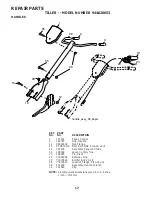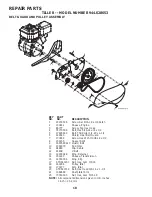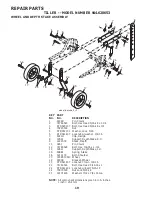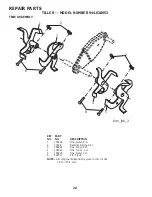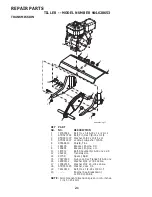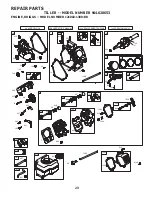
8
OPERATION
ADD GASOLINE
•
Fill fuel tank to bottom of filler neck. Do not overfill.
Use fresh, clean, regular un lead ed gasoline with a
minimum of 87 octane. (Use of leaded gasoline will
increase carbon and lead oxide deposits and reduce
valve life). Do not mix oil with gasoline. Purchase fuel
in quan ti ties that can be used within 30 days to assure
fuel freshness.
CAUTION: Fill to within 1/2 inch of top
of fuel tank to prevent spills and to
allow for fuel expansion. If gasoline
is ac ci den tal ly spilled, move machine
away from area of spill. Avoid creating
any source of ignition until gasoline
vapors have disappeared.
Wipe off any spilled oil or fuel. Do not
store, spill or use gasoline near an
open flame.
IMPORTANT: WHEN OPERATING IN TEMPERATURES
BELOW32°F(0°C), USE FRESH, CLEAN WINTER GRADE
GAS O LINE TO HELP INSURE GOOD COLD WEATHER
START ING.
Fig. 8
ngi
ne_
art
_4
OIL
FILLER
PLUG
OIL
LEVEL
BEFORE STARTING ENGINE
IMPORTANT: BE VERY CAREFUL NOT TO ALLOW DIRT
TO ENTER THE ENGINE WHEN CHECKING OR ADDING
OIL OR FUEL. USE CLEAN OIL AND FUEL AND STORE IN
AP PROVED, CLEAN, COVERED CONTAINERS. USE CLEAN
FILL FUNNELS.
FILL ENGINE WITH OIL (See Fig. 7)
•
With engine level, remove engine oil filler plug.
•
Fill engine with oil to point of overflowing. For ap proxi-
mate ca pac i ty see “PRODUCT SPEC I FI CA TIONS” on
page 3 of this manual.
•
Tilt tiller back on its wheels and then re-level.
•
With engine level, refill to point of overflowing if nec es-
sary. Re place oil filler plug.
•
For cold weather operation you should change oil for
easier starting (See “OIL VISCOSITY CHART” in the
Maintenance section of this manual).
•
To change engine oil, see the Maintenance section of
this manual.
FIG. 7
TO START ENGINE (See Fig. 8)
CAUTION: Keep tine control in “OFF”
position when starting engine.
When starting engine for the first time or if engine has run
out of fuel, it will take extra pulls of the recoil starter to
move fuel from the tank to the engine.
•
Make sure spark plug wire is prop er ly connected.
•
Place throttle control in “FAST” position.
•
Move choke control to full “CHOKE” position. Grasp
recoil starter handle with one hand and grasp tiller
handle with other hand. Pull rope out slowly until en-
gine reaches start of com pres sion cycle (rope will pull
slightly harder at this point).
•
Pull recoil starter handle quickly. Do not let starter handle
snap back against starter. Repeat if necessary.
•
If engine fires but does not start, move choke control
to half choke position. Pull recoil starter handle until
engine starts.
•
When engine starts, slowly move choke control to
“RUN” position as engine warms up.
NOTE: A warm engine requires less choking to start.
•
Move throttle control to desired running position.
•
Allow engine to warm up for a few minutes before
engaging tines.
NOTE: If at a high altitude (3000 feet) or in cold
temperatures (below 32°F), the carburetor fuel mixture
may need to be adjusted for best engine performance.
See “TO ADJUST CARBURETOR” in the Service and
Adjustments section of this manual.
NOTE: If engine does not start, see troubleshooting
points.
CAUTION: Alcohol blended fuels (called gas o hol
or using ethanol or methanol) can attract mois-
ture which leads to sep a ra tion and for ma tion of
acids during storage. Acidic gas can damage
the fuel system of an engine while in storage. To
avoid engine problems, the fuel system should
be emptied before stor age of 30 days or longer.
Drain the gas tank, start the engine and let it run
until the fuel lines and carburetor are empty. Use
fresh fuel next sea son. See Storage In struc tions
for additional information. Never use engine or
carburetor cleaner products in the fuel tank or
permanent damage may occur.
RE COIL
STARTER HANDLE
THROT TLE
CON TROL
CHOKE
CON TROL
SPARK
PLUG

















